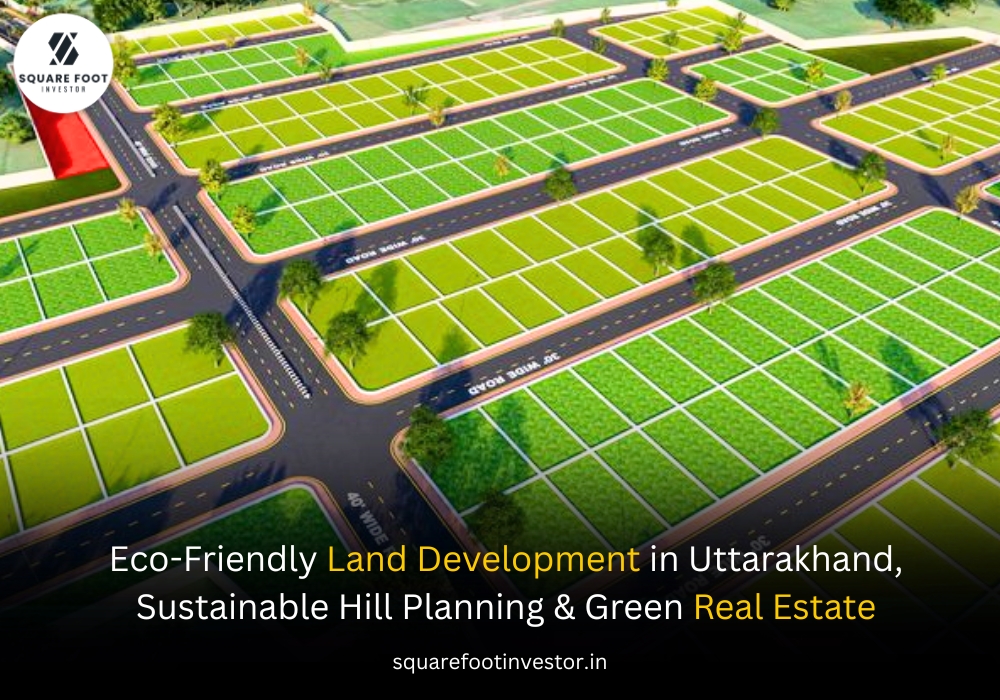Nature has its own balance; the more we disturb it, the louder it reminds us.”
That quote perfectly sums up what’s happening across the hills of Uttarakhand today.
Every year, the headlines repeat themselves: “Cloudburst in Tehri,” “Flash floods in Rudraprayag,” “Riverside resorts washed away in Nainital district.” Behind these tragedies lies one common cause: unplanned, eco-insensitive land development.
In a state where the Himalayas meet the Ganga, every slope, stream, and forest patch carries a delicate equilibrium. The way we build here matters, not just for comfort but for survival.
In today’s blog we’ll discuss the necessity of eco-friendly land development, as well as the challenges and opportunities it presents.
Why Does Green Planning Matters?

Uttarakhand, which is called the land of god, is one of India’s beautiful and eco-rich states. Its snow-draped peaks, fertile forests, and pure rivers are the source of northern India’s water system. But this slice of paradise is under threat due to rapid and unplanned construction.
Eco-friendly land development in Uttarakhand is no longer a trend anymore; it is a basic need! It’s finding that delicate balance between development and ecology to ensure the hills remain habitable, beautiful, and resilient for future generations.
What is Eco-Friendly Land Development?
Eco-friendly land development means using land wisely and responsibly, creating structures that adapt to nature rather than fight against it. It blends smart design, sustainable materials, and local wisdom to ensure that growth happens without harming the environment.
“It’s not about stopping development, it’s about developing rightly.”
Key Principles of Eco-Friendly Land Development in Uttarakhand:
- Respect the slope and natural water flow: Never block natural drainage or alter hill gradients.
- Use local and renewable building materials: Stone, bamboo, and mud provide durability while blending with the landscape.
- Conserve forests and green buffers: Maintain green cover to prevent landslides and promote biodiversity.
- Water management: Rainwater harvesting, recharge pits, and drainage mapping are essential.
- Use renewable energy: Solar panels and energy-efficient systems reduce the carbon footprint.
- Limit concrete use: Encourage previous pavements that allow groundwater recharge.
Why Uttarakhand Needs Sustainable Planning Now?
Uttarakhand, which is called the land of god, is one of India’s beautiful and eco-rich states. Its snow-draped peaks, fertile forests, and pure rivers are the source of northern India’s water system. But this slice of paradise is under threat due to rapid and unplanned construction.
Eco-friendly land development in Uttarakhand is no longer a trend anymore; it is a basic need! It’s finding that delicate balance between development and ecology to ensure the hills remain habitable, beautiful, and resilient for future generations.
The Reality of Hill Development: Nature is Warning Us

In the past few months you have seen news of a devastating cloudburst in Uttarkashi’s Dharali village triggered massive flash floods and landslides.
The flood washed away several homes, hotels, and roads, leaving multiple people missing and causing large-scale damage.In the past few months, we all witnessed the news of a devastating cloudburst in Uttarkashi’s Dharali village, which triggered massive flash floods and landslides, sweeping away homes, roads, and riverside resorts
- Experts say unplanned riverside construction and deforestation intensified the destruction.
- Natural drainage channels were blocked due to land cutting for resorts and homestays — worsening the flood’s impact.
- Steep slope excavation without proper retaining structures led to soil collapse and debris flow.
- The incident reignited debate on hill-safe zoning, green building codes, and eco-sensitive land use planning in Uttarakhand.
- It’s a stark reminder that nature-based planning — not blind construction — is the only sustainable path for the hills.
- Experts have repeatedly warned: building too close to riverbanks, cutting steep slopes for resorts, and ignoring natural drainage channels are inviting disasters.
Challenges & Opportunities for Hill Zones in Uttarakhand
While the eco-friendly land development in Uttarakhand offers giant potential, at the same time the state faces unique challenges:
Hilly Terrain: An unplanned cut can be hazardous due to soil erosion and slope instability.
Water Management: Rapid construction has blocked off natural drainage lines.
Deforestation: Building with timber raises the risk of flooding.
Tourism Pressure: Hundreds of thousands of seasonal visitors seek increasingly quick, inexpensive resorts.
However, there are also opportunities:
- Growing interest in ecotourism and sustainable real estate.
- The state of Uttarakhand supports green housing plans.
- Existence of solar incentives and rebates for energy-efficient buildings.
- Eco-homes for conscious buyers in the Uttarakhand Nainital vicinity (Bhimtal / Mukteshwar / Dehradun, etc.)
- These prospects are slowly turning sustainable planning into not only the right thing to do but also the financially well-advised one as well.
Schemes & Initiatives in Uttarakhand
Uttarakhand is gradually adopting sustainable development through various types of programs:
- State Disaster Management Policy: This policy promotes slope stability and disaster-safe building practices.
- Eco-Tourism Policy: Encourages nature-based tourism projects using local materials.
- Solar Policy of Uttarakhand: This policy provides subsidies for rooftop solar installation.
- Green Building Incentives: Urban bodies offer incentives for energy-efficient construction.
Practical Strategies for Developers & Landowners
If you are planning to buy or develop an eco-friendly land development in Uttarakhand, here are practical eco-friendly strategies to consider:
- Before beginning construction, conduct slope and soil analysis.
- Avoid riverbanks and flood zones, and maintain natural buffers.
- Build tiny and blend in with the environment, using terraces rather than deep foundations.
- Install solar water heaters and LED systems.
- Implement solid waste segregation and composting.
- Use water-permeable pavements to recharge groundwater.
- Plant native vegetation to prevent erosion.
Eco-Friendly Development Checklist for Uttarakhand Hills
| Aspect | Sustainable Practice | Benefit |
| Land Use | Build away from slopes & rivers | Prevents erosion & flood damage |
| Materials | Use stone, bamboo, mud | Reduces carbon footprint |
| Energy | Solar rooftops & natural light | Lowers electricity cost |
| Water | Rainwater harvesting, drainage maps | Conserves groundwater |
| Waste | Composting & recycling | Keeps surroundings clean |
| Plantation | Native trees & shrubs | Stabilizes soil & enhances beauty |
| Architecture | Low-rise, terrain-fitting design | Preserves natural landscape |
Why Investing in Green Real Estate Makes Sense
Eco-friendly land development in Uttarakhand offers not only environmental stability but also strong investment potential.
Here’s why:

- Properties built sustainably enjoy higher resale and rental value.
- Green projects have lower maintenance and energy costs.
- They are more resilient to natural calamities.
- Eco-housing aligns with global sustainability trends, attracting conscious investors.
If you’re planning to invest in Uttarakhand then Platforms like Squarefoot Investor are helping people discover eco-friendly land for sale in Uttarakhand, offering verified plots that balance accessibility, natural beauty, and responsible development.
Conclusion: Build With Nature, Not Against It
Green building is no longer a choice—it’s a need.
By combining ancient wisdom with contemporary sustainability by building smarter, not faster, we can make sure Uttarakhand’s development does not come at the expense of its natural beauty or its safety.
When we talk about eco-friendly land development in Uttarakhand, we’re not only talking about construction but also about life in the Himalayas.
Let’s not wait for another flood or cloudburst to recollect that.
Explore Further: Visit our blog section for more green investment ideas.
FAQ’s on Eco Friendly Land Development
What is eco-friendly land development in Uttarakhand?
It’s the process of planning and building homes that adapt to the natural terrain using sustainable materials, renewable energy, and water-conserving systems.
Why is eco-friendly development important for Uttarakhand hills?
Because it helps prevent floods, landslides, and soil erosion while maintaining the ecological balance of the Himalayas
Why is eco-friendly land development important?
It helps save natural resources, cut pollution, and create healthier living spaces.
How can developers adopt eco-friendly methods in Uttarakhand??
By using local materials like stone or bamboo, installing solar panels, managing drainage, and practicing rainwater harvesting.
Is eco-friendly land development costly?
No, it saves money in the long run through energy efficiency and low maintenance.




